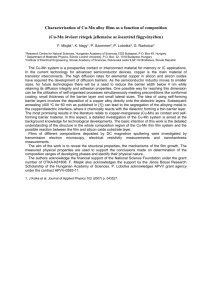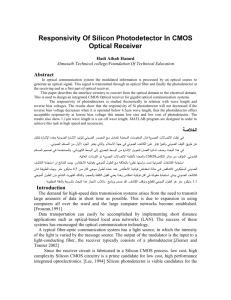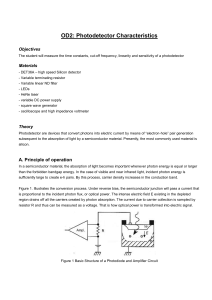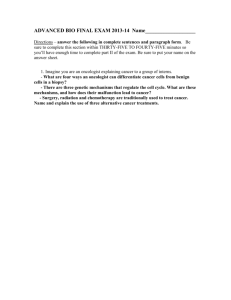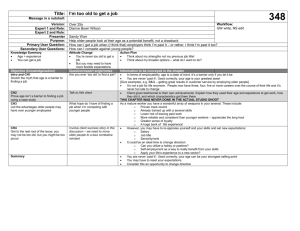Photodetector on Silicon
advertisement
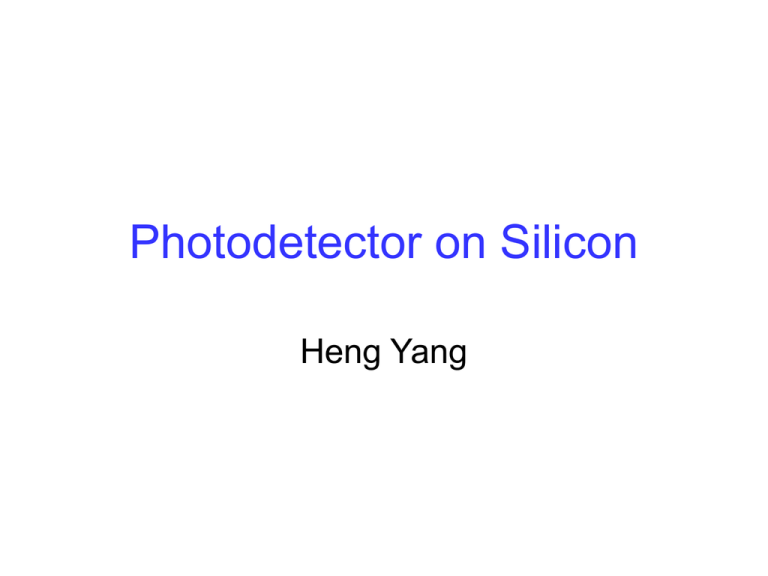
Photodetector on Silicon Heng Yang Outline • Introduction • Si Photodetector in 770 ~ 850 nm Range • IR Schottky barrier photodetector Introduction • Essentially - p-n diode under the reverse bias • Operate in the photoconductive mode • Main usage - for the conversion of the optical signal • works at 0.3 - 1.1 µm (peak responsivity at 0.8 µm). Si Photodetector in 770 ~ 850 nm Range • • • • Optical communication range. Absorption length for Si: 10 ~ 15 mm. Requirements: High responsivity and Fast? pn, pin and msm. n Depletion region p J = Jdrfit + Jdiff Interdigitated Electrode Interdigitated electrodes are often used to increase the active region area while optimizing the electric fields in the carrier collection region. Electrode can either be P+/N+ or just metal. Silicon Lateral Trench Photodetector Finger space = 3.3 mm Trench depth = 8 mm Finger size = 0.35 mm For l=845 nm, BW=1.5 GHz, Responsivity = 0.47 A/W at 5V Min Yang, Kern Rim, Dennis L. Rogers, et al., IEEE ELECTRON DEVICE LETTERS, VOL. 23, NO. 7, JULY 2002 MSM Photodetector by Trench Formation For l = 790 nm, BW = 2.2 GHz, Responsivity = 0.14 A/W @ 5V Jacob Y. L. Ho and K. S. Wong, IEEE Photonics Technology Letters, 8(8), 1996 Resonant-Cavity-Enhanced HighSpeed Si Photodetector Three pair of quarter wavelength SiO2 and polysilicon at bottom (LPCVD). Etched seed window. SiO2 Side-wall to prevent defects at the edge of poly. RPCVD Si. Two pairs of ZnSe-MgF on top (evaporated). J. D. Schaub, R. Li, C. L. Schow, J. C. Campbell, G. W. Neudeck, and J. Denton ,IEEE PHOTONICS TECHNOLOGY LETTERS, VOL. 11, NO. 12, DECEMBER 1999 Photodetector on SOI • Thin active layer, and small finger space result in high speed. • Device with 100nm active layer and 100nm finger space was made. l=780 nm BW=140 GHz, responsivity=5.7 mA/W @ 5V. Silicon dioxide Silicon M. Y. Liu, E. Chen, and S. Y. Chou, Appl. Phys. Lett. 65 (7), 15 August 1994 IR Schottky Barrier (SB) Photodetector 300,000 PtSi/p-Si Schottky barrier IR detector focal plane arrays have been developed and used on Air Force B-52 IR Schottky Barrier Photodetector Internal Photoemission 1.24 lC q B Intrinsic Mechanism Issues • High dark current, has to operate at low temperature (40 ~ 80 K). • Low quantum efficiency (QE). h qB 2 QE C1 h 1 1 1.24C1l l lC 2 High lC gives high QE. In order to expand the spectrum, efforts were made to decrease the barrier height. Fowler Plot • The dark current is thermionic limited. It is given by: J 0 A * *T 2 exp( qB / kT ) • A** is Richardson constant • By plotting J0/T2 vs 1/T, qB can be obtained from the slope. PtSi/p-Si Schottky Barrier • Second lowest barrier height (0.22eV). More than IrSi (0.16eV). • Low expense. • Compatible with standard IC process. • Stable. • Good uniformity over large area. • Good growth and etching selectivity. PtSi Schottky-Barrier Infrared Focal Plane Arrays Masafumi Kimata, Tatsuo Ozaki, Natsuro Tsubouchi and Sho Ito, Proceeding of SPIE, 1998 SBD with a shallow P+ layer • PtSi/p-Si, qFB = 0.22 eV, lc = 5.6 mm. (M. Kimata, M. Denda et. al, Inter. J. of Infrared and millimeter waves, 6(10), 1985) • PtSi/p+ (100 ~ 300 nm)/p-Si, qFB < 0.22 eV, with hole tunneling, lc = 7 mm. (CY Wei, W. Trantraporn, W. Katz and G. Smith, 93, 1981) • PtSi/p+ (1nm)/p-Si, qFB = 0.057 eV, lc = 22 mm. (TL Lin, JS Park et. al, Appl. Phys. Lett. 62(25), 1993) TL Lin, JS Park et al. Appl. Phys. Lett. 62(25), 1993 Porous Silicon (PS) Schottky Barrier Detector • The modification was made just to make the PtSi on top of the PS in stead of Si. Pt was deposited by electrodeposition • The cut-off wavelength of 7 mm was reported. • QE ~ 10% @ 7 mm • Random orientation of the junctions increase the number of holes that can be injected into Si. Farshid Raissi and Mansoor Mohtashami Far, IEEE Sensors Journal, 2 (5) 2002


